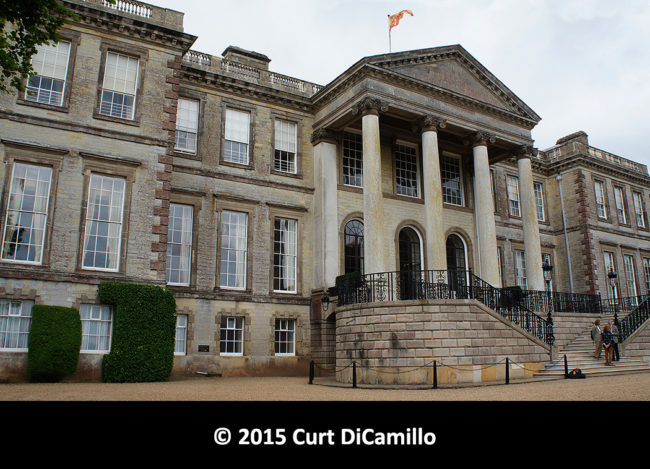
The entrance facade
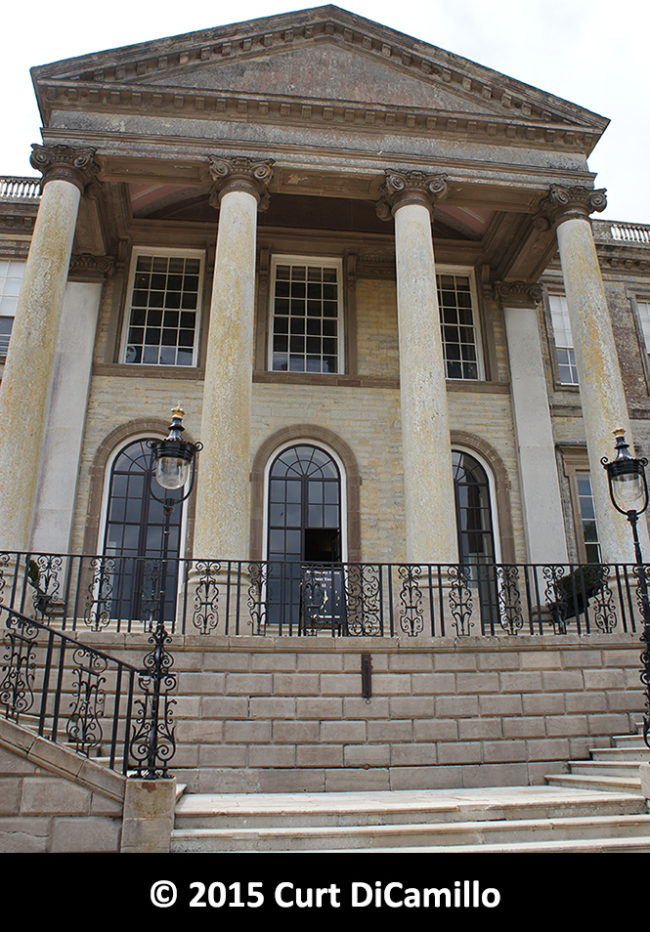
Entrance facade portico
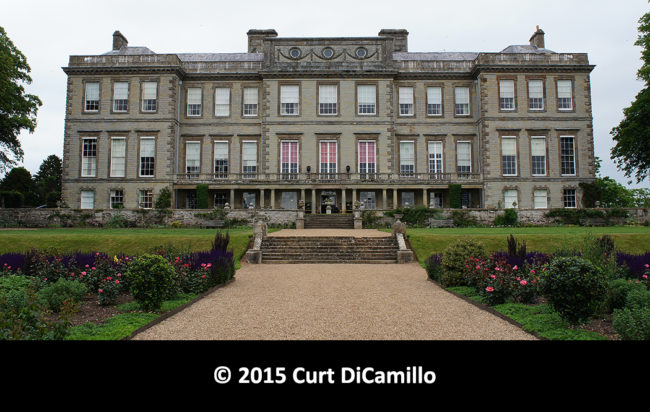
The garden facade
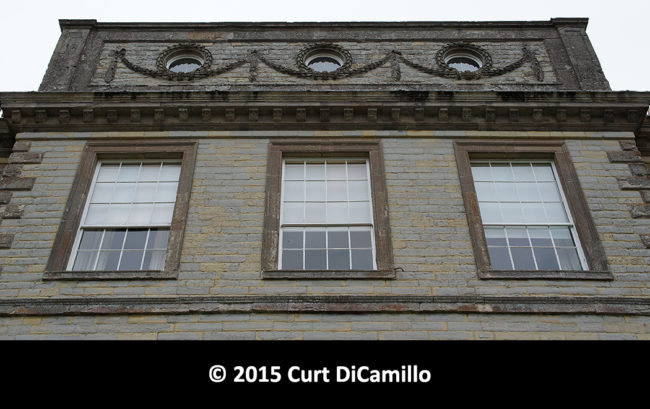
Detail of garden facade
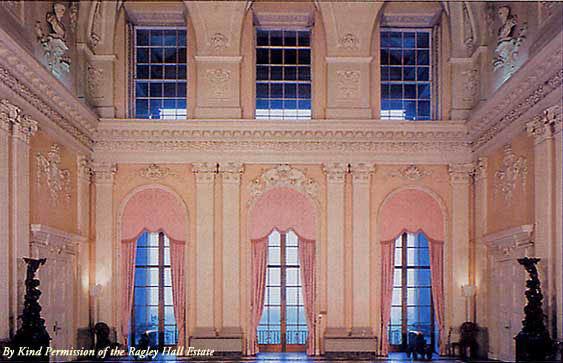
The Great Hall
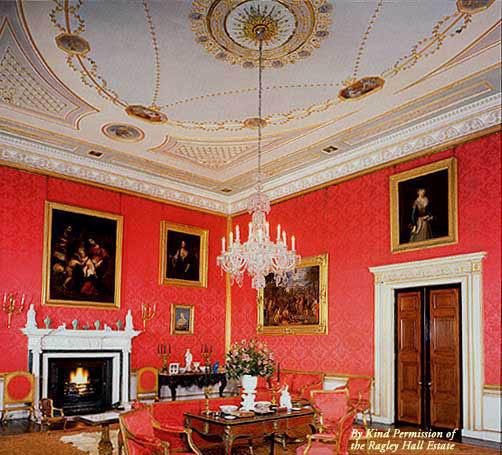
The Red Saloon
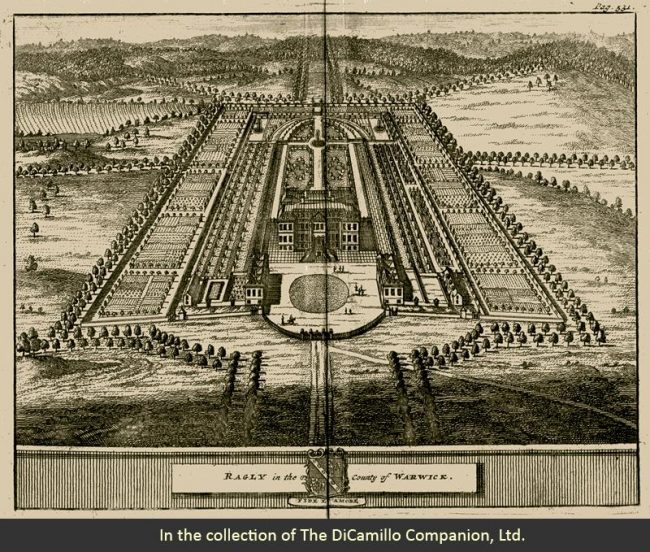
Bird's eye view of the house and garden from a circa 1720 Kupferstich engraving
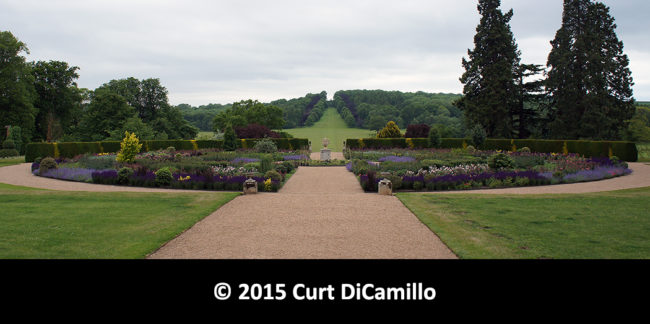
Rear garden
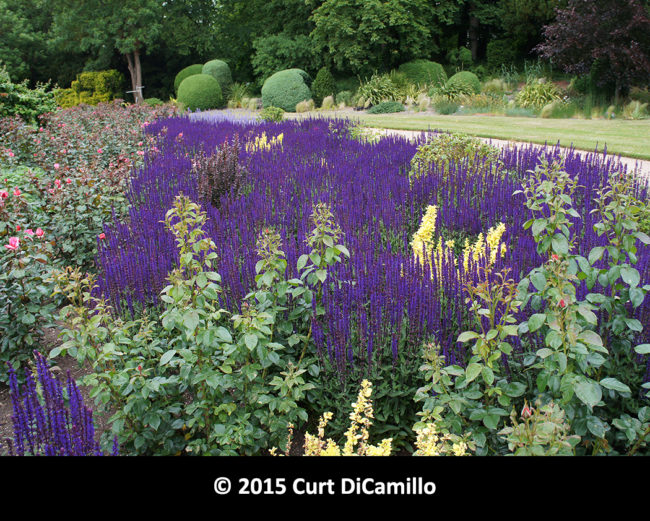
Rear garden
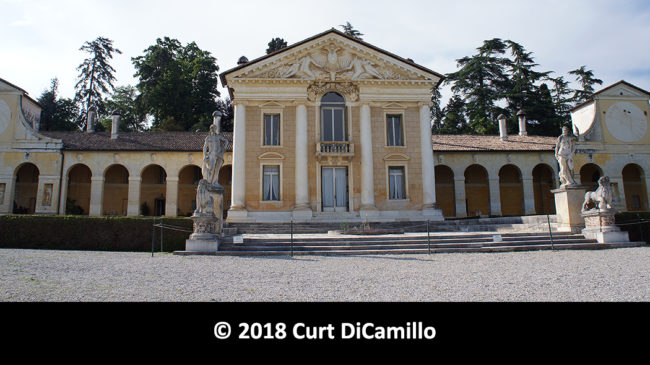
Villa Barbaro, Veneto, whose murals inspired Graham Rust's 20th century mural at Ragley
Earlier Houses: The Old Hall stood where the Rose Garden now lies.
House & Family History: Ragley is a Saxon word meaning rubbish dump. During the reign of Elizabeth I Sir John Conway came from Conway Castle in North Wales, purchased the Ragley Estate (the last time the estate changed hands by purchase) and married a local heiress. Sir John's great grandson was created 1st Earl of Conway by Charles II. The 1st Earl commissioned Robert Hooke to design the existing house, but died before it was completed. His only child, a daughter, inherited the Ragley Estate. She was engaged to a cousin, Popham Seymour, who was killed in a duel; she died soon thereafter and Ragley was inherited by Popham's younger brother, Francis Seymour. In 1750 Francis Seymour-Conway, 2nd Baron Conway, was created Viscount Beauchamp and 1st Earl of Hertford. In 1793 he was elevated as 1st Marquess of Hertford for his service governing Ireland. He was later ambassador to France, a knight of the Garter, and lord chamberlain of England. The 2nd Marquess was a close friend of the Prince Regent, whose attention to the marchioness caused a scandal. The 3rd Marquess formed a large collection of paintings thanks to the fortune inherited by his wife, Maria Emilia Fagnani. Most of the collection, greatly enhanced by his son (the 3rd Marquess) and grandson (Sir Richard Wallace), today survives in London as the Wallace Collection. The 3rd Marquess was also the model for two important fictional literary characters: Lord Steyne in William Makepeace Thackeray's "Vanity Fair" and the Marquess of Monmouth in Benjamin Disraeli's novel "Coningsby." The 4th Marquess spent his life adding to the collection started by his father; he never married and left everything, except Ragley and Conway Castle, to Richard Wallace, his illegitimate son. Wallace left the collection to the nation upon his death. The 5th Marquess sold Conway Castle and restored some of the rooms at Ragley. He was lord chamberlain to Queen Victoria and equerry to Prince Albert. During World War II Ragley was used as a hospital. In 1964 the 8th Marquess announced that he was going to demolish the house because of enormous repair bills and high operating costs. He was eventually persuaded to change his mind and Ragley received grants of £18,000 from the Historic Buildings Council to help in its preservation. The spectacular, pink great hall is 70 feet long by 40 feet wide by 40 feet high and still contains the furniture made for it in 1756. The Prince Regent's Bedroom contains a bed built for the prince for his first visit to Ragley in 1796. It was in this bed that the prince was told of the death of his only child, Princess Charlotte. On the library walls hangs a portrait of Horace Walpole by Joshua Reynolds that was originally at Strawberry Hill (Walpole was a frequent visitor to Ragley and a cousin of the 1st Marquess). The library also contains fine carvings by Grinling Gibbons over the doors. Between October 1969 and March 1983 Graham Rust painted a mural of his own design on the walls of the south staircase hall. Entitled "The Temptation," it's based on the frescoes at the Villa Barbaro in the Veneto and is said to be the largest mural in England.
Collections: A large carriage collection, dating to 1760, is housed on the grounds. The Ante Room contains a 17th century bronze horse made in Florence, probably by Pietro Tacca. The red saloon contains Cornelius van Haarlem's "The Raising of Lazarus" and a jade duck that was looted from the Imperial Palace in the Forbidden City in 1900 during the Boxer Rebellion.
Comments: Ragley is considered one of the earliest and finest of the Palladian style English country houses.
Garden & Outbuildings: Ragley is a working agricultural estate, with over 6,000 acres of land. The house is set within 27 acres of gardens, including the famous Rose Garden. Capability Brown landscaped the grounds.
Architect: James Wyatt
Date: 1779-97John Preston (J.P.) Neale, published under the title of Views of the Seats of Noblemen and Gentlemen in England, Wales, Scotland, and Ireland, among other titles: Vol. IV, 1821.
Country Life: LV, 438, 476. CXX, 15. CXXIII, 938, 1006 XIII, 571.
Title: Biographical Dictionary of British Architects, 1600-1840, A - SOFTBACK
Author: Colvin, Howard
Year Published: 1995
Reference: pgs. 509, 1115
Publisher: New Haven: Yale University Press
ISBN: 0300072074
Book Type: Softback
Title: Country Life Cumulative Index: Volumes I to CXCIII to December 1999
Author: NA
Year Published: 2000
Publisher: London: IPC Magazines Limited
ISBN: NA
Book Type: Light Softback
Title: Ragley Guidebook
Author: NA
Year Published: 1998
Publisher: Derby: English Life Publications Ltd.
ISBN: 085101299X
Book Type: Light Softback
House Listed: Grade I
Park Listed: Grade II*
Current Seat / Home of: Henry Jocelyn Seymour, 9th Marquess of Hertford
Past Seat / Home of: Francis Seymour-Conway, 1st Marquess of Hertford, 1st Earl of Hertford, 1st Viscount Beauchamp, and 2nd Baron Conway, until 1794; Francis Ingram-Seymour-Conway, 2nd Marquess of Hertford, 1794-1822; Francis Charles Seymour-Conway, 3rd Marquess of Hertford, 1822-42; Richard Seymour-Conway, 4th Marquess of Hertford, 1842-70; Francis Hugh George Seymour, 5th Marquess of Hertford, 1870-84; Hugh de Grey Seymour, 6th Marquess of Hertford, 1884-1912; George Francis Alexander Seymour, 7th Marquess of Hertford, 1912-40; Hugh Edward Conway Seymour, 8th Marquess of Hertford, 1940-97.
Current Ownership Type: Individual / Family Trust
Primary Current Ownership Use: Private Home
House Open to Public: Yes
Phone: 01789-762-090
Fax: 01789-764-791
Email: [email protected]
Website: https://www.ragley.co.uk
Historic Houses Member: Yes